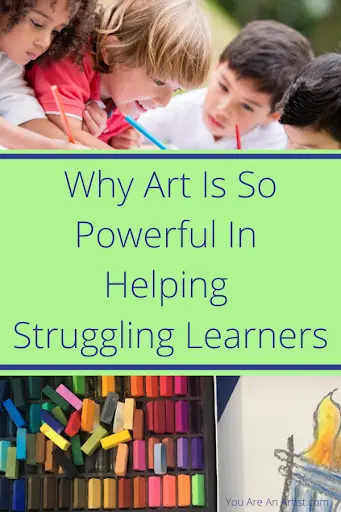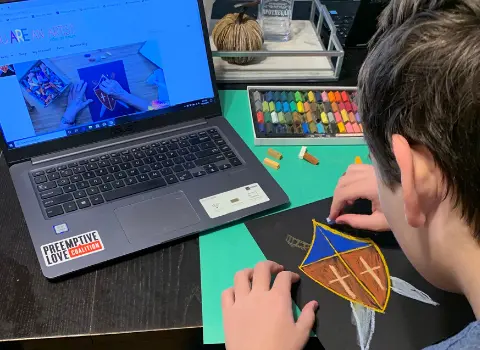When I was in school, I had a complicated relationship with art. I was a very type A, by the book, just give me a worksheet and let me fill in the blanks kind of learner. For me, art seemed to be unnecessary and, at times, it frustrated me. (That, and I thought I was pretty awful at it). Fast forward 25 years to when I found out why art is so powerful in helping struggling learners.

Now, I am homeschooling two boys who are vastly different learners than I was at their age. (For example, no matter how much I love them myself, I never give them a worksheet if I actually want them to learn.)
Homeschooling Children With Learning Differences
Not only are their learning styles different than mine, but they also struggle with learning differences. My oldest is on the autism spectrum and profoundly dysgraphic. My youngest has attention, sensory and processing issues and is also profoundly dyslexic and dysgraphic.
Helping them learn in ways that allow them to actually retain the information has been a daily challenge. Moreover, it has required me to look beyond my own school experience and instead, consider what actually helps them make progress.
To my surprise, art has become an essential element of their learning, in almost every subject.
Here’s why.
Why Art Is So Powerful In Helping Struggling Learners
Through a lot of trial and error, my own research, and work with outside therapists, there are three things that I have found work best for my children, and for most kids struggling with a traditional school approach.
- Multi-sensory learning
- Short lessons
- Moving at the child’s pace and allowing him to explore
You Are An Artist lessons naturally incorporate these three essential ingredients in ways that have helped my own children immensely. Nana and her sweet, kind, artist’s way have become a staple of our learning, precisely because they work so well with my boys’ learning needs.
Integrated Art With You Are An Artist Is Perfect For My Struggling Learners
There are several reasons why this program is such a good fit for us.
Multi-Sensory Approach
As I mentioned, this is essential for any learner who is not connecting with the standard textbook and worksheet approach to learning.
You Are An Artist’s multi-sensory approach allows my sons to use their hands, experience the “feel” of the medium, see the video, and hear the sound of Nana gently guiding them through not just the art, but the history or science lesson as well.
For my kids, this makes it “stick” in ways that I would not have expected. Because they are engaged in the multi-sensory components of the learning, their brain is much better able to retain what is being taught (and it’s way more fun!).
Perfect for the Perfectionist
We tried art therapy for my youngest son a few years ago, with mixed results.
Most of what got in the way of him being able to relax and engage, was the feeling of needing to make his art “perfect.” (If I think back to my own experience in school, I am pretty sure I felt the same way and disconnected from art because of it.)
Using chalk pastels has completely changed this for him. Because they are not as precise as using a pencil, crayon or marker, he can make “mistakes” without feeling like his project is ruined. Chalk pastels are also incredibly helpful for a child with gaps in fine motor skills.
Plus, it helps that Nana always gently reminds her students that mistakes aren’t really mistakes in art, and even makes a few herself to model flexibility.
Pressure Free Learning
Using art in more traditional subjects completely changes the tone of the learning for my boys. Rather than worrying about whether they will be able to keep up, they relax into a much softer, but just as effective learning environment.
Shorter, well-paced lessons combined with the multi-sensory nature of the learning means a struggling learner can connect with the topic without the pressure of performance or fear of failure.
I would never have predicted how much art, and especially You Are An Artist, would help my children learn.
But the truth is, it has and it continues to, even as they get older.
Finding ways to connect with struggling learners can be difficult, but it doesn’t have to be. You Are An Artist is a great place to start.
You might also like:
- I Drew It Then I Knew It video art lessons
- From Nana’s Porch Podcast
- You ARE an Artist Clubhouse Course Listing
- 10 Benefits of Artist Clubhouse Membership
- Free Homeschool Curriculum Match Up Checklist download to make planning art time easier



